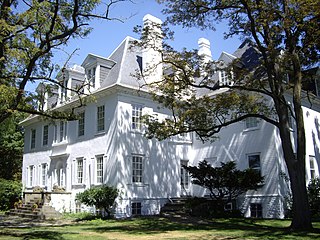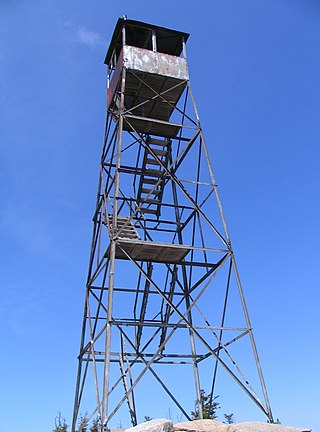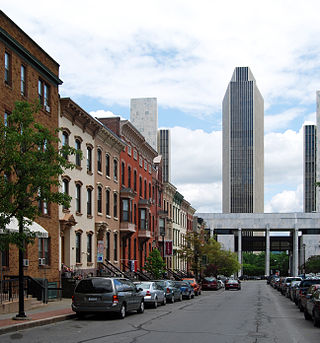
Livingston is a city in and the county seat of Sumter County, Alabama, United States and the home of the University of West Alabama. By an act of the state legislature, it was incorporated on January 10, 1835. At the 2010 census the population was 3,485, up from 3,297 in 2000. It was named in honor of Edward Livingston, of the Livingston family of New York.

Livingston is a town in Columbia County, New York, United States. The population was 3,628 at the 2020 census. The town is named after its founding father.

The Clermont State Historic Site, also known as the Clermont estate, the Clermont Manor or just Clermont, is a New York State Historic Site in southwestern Columbia County, New York, United States. It protects the former estate of the Livingston family, seven generations of whom lived on the site over more than two centuries.

The Henry Guest House is in New Brunswick, Middlesex County, New Jersey, at Livingston Avenue and Morris Street. It was originally located on New Street between Livingston Avenue and George Street. The Georgian stone farmhouse was built in 1760 by Henry Guest. He was a New Brunswick alderman and an associate of John Adams and author Thomas Paine. It was added to the National Register of Historic Places on May 24, 1976.

This is intended to be a complete list of properties and districts listed on the National Register of Historic Places in Orleans County, New York. The locations of National Register properties and districts may be seen in a map by clicking on "Map of all coordinates". Two listings, the New York State Barge Canal and the Cobblestone Historic District, are further designated a National Historic Landmark.

The neighborhoods of Albany, New York are listed below.

Liberty Hall, also known as the Governor William Livingston House, located on Morris Avenue in Union, Union County, New Jersey, United States, is a historic home where many leading influential people lived. It was documented by the Historic American Buildings Survey (HABS) in 1938. The house was added to the National Register of Historic Places as a National Historic Landmark on November 28, 1972, for its significance in politics and government. It is now the Liberty Hall Museum.

Clarkson Chapel is located on New York State Route 9G in Clermont, New York, United States, just across from the Coons House. It is a mid-19th century wooden building in the Carpenter Gothic style.

There are 75 properties listed on the National Register of Historic Places in Albany, New York, United States. Six are additionally designated as National Historic Landmarks (NHLs), the most of any city in the state after New York City. Another 14 are historic districts, for which 20 of the listings are also contributing properties. Two properties, both buildings, that had been listed in the past but have since been demolished have been delisted; one building that is also no longer extant remains listed.
Copake United Methodist Church and Copake Cemetery is a historic United Methodist church on Church Street in Copake, Columbia County, New York. The church was built about 1854 and is a one-story, timber frame meeting house style church with Greek Revival style design attributes. It features a stoutly proportioned, four columned Ionic order portico and a two tiered belfry. The church is set within Copake Cemetery. The earliest burial dates to 1757 and most of the stones date to the first decades of the 19th century.

Livingston Memorial Church and Burial Ground is a historic Dutch Reformed church at CR 10 & Wire Road in Linlithgo, Columbia County, New York. It was built in 1870 on the site of the original 1721 church and above the Livingston family burial crypt established in 1727. It is on land provided by Robert Livingston the Elder (1654-1728) in his will. It is a one-story, rectangular brick structure, 48 feet long and 24 feet wide. It features a square tower added to the building in 1890 and Gothic arched windows. The burial ground contains 39 stones, with the earliest dating to 1772-1781; burials ceased in 1890.

Richmond Hill is a historic home and farm complex located at Livingston in Columbia County, New York.
Dick House is a historic home located at Germantown in Columbia County, New York. It was built about 1860 and is five bays wide and two bays deep with a gable roof. There is a flat roofed west wing. It has a center hall plan with Italianate style detailing on the interior.

The Hurricane Mountain Fire Observation Station is a historic fire observation station located on Hurricane Mountain at Keene in Essex County, New York. The station and contributing resources include a 35-foot-tall (10.7 m), steel frame lookout tower erected in 1919, two trails leading up the 3,694-foot (1,126 m) summit, and the ruins of a lean-to style observers cabin. The tower is a prefabricated structure built by the Aermotor Corporation to provide a front line of defense in preserving the Adirondack Park from the hazards of forest fires.

Engleside is a historic estate located near Dansville in Livingston County, New York. The estate includes the large Greek Revival style main house, barn, single bay garage, and a combination laundry / drying house / privy building. The main house was built around 1848. It is composed of a two-story three bay, side hall entrance main block surmounted by a hipped roof with a long wing. The property also features a stone retaining wall with integrated quarter circle flights of steps and a cast iron fountain.

The architecture of Albany, New York, embraces a variety of architectural styles ranging from the early 18th century to the present. The city's roots date from the early 17th century and few buildings survive from that era or from the 18th and early 19th century. The completion of the Erie Canal in 1825 triggered a building boom, which continued until the Great Depression and the suburbanization of the area afterward. This accounts for much of the construction in the city's urban core along the Hudson River. Since then most construction has been largely residential, as the city spread out to its current boundaries, although there have been some large government building complexes in the modernist style, such as Empire State Plaza, which includes the Erastus Corning Tower, the tallest building in New York outside of New York City.
This is a timeline and chronology of the history of Brooklyn, New York. Brooklyn is the most populous of New York City's boroughs, and was settled in 1646.
Esenwein & Johnnson was an architectural firm of Buffalo, New York.

















